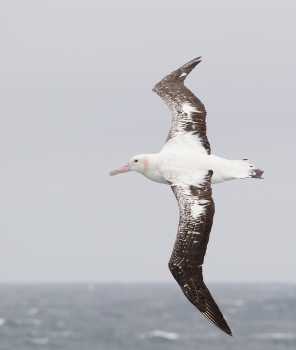Felipe Ceia (Marine and Environmental Research Centre, University of Coimbra, Portugal) and colleagues have published in the journal Rapid Communications in Mass Spectrometry on stable isotope ratios in the blood of tracked Wandering Albatrosses Diomedea exulans.
The paper’s abstract follows:
“Rationale
The main limitation of isotopic tracking for inferring distribution is the lack of detailed reference maps of the isotopic landscape (i.e. isoscapes) in the marine environment. Here, we attempt to map the marine δ13C isoscape for the southwestern sector of the Atlantic Ocean, and assess any temporal variation using the wandering albatross as a model species.
Methods
Tracking data and blood and diet samples were collected monthly from wandering albatrosses rearing chicks at Bird Island, South Georgia, during the austral winter between May and October 2009. The δ13C and δ15N values were measured by mass spectrometry in plasma and blood cells, and related to highly accurate data on individual movements and feeding activity obtained using three types of device: GPS, activity (immersion) loggers and stomach temperature probes.
Results
The tracked birds foraged in waters to the north or northwest of South Georgia, including the Patagonian shelf-break, as far as 2000 km from the colony. The foraging region encompassed the two main fronts in the Southern Ocean (Polar and Subantarctic fronts). The δ13C values varied by only 2.1 ‰ in plasma and 2.5 ‰ in blood cells, and no relationships were found between the δ13C values in plasma and the mean latitude or longitude of landings or feeding events of each individual.
Conclusions
The failure to distinguish a major biogeographic gradient in δ13C values suggest that these values in the south Atlantic Ocean are fairly homogeneous. There was no substantial variation among months in either the δ13C or the δ15N values of plasma or blood cells of tracked birds. As birds did not show a significant change in diet composition or foraging areas during the study period, these results provide no evidence for major temporal variation in stable isotope ratios in consumer tissues, or in the regional marine isoscape in the austral winter of 2009.”

Wandering Albatross at sea, photograph by John Chardine
Reference:
Ceia, F.R., Ramos, J.A., Phillips, R.A., Cherel, Y., Jones, D.C., Vieira, R.P. & Xavier, J.C. 2015. Analysis of stable isotope ratios in blood of tracked wandering albatrosses fails to distinguish a δ13C gradient within their winter foraging areas in the southwest Atlantic Ocean. Rapid Communications in Mass Spectrometry 29: 2328-2336.
John Cooper, ACAP Information Officer, 15 November 2015

 English
English  Français
Français  Español
Español